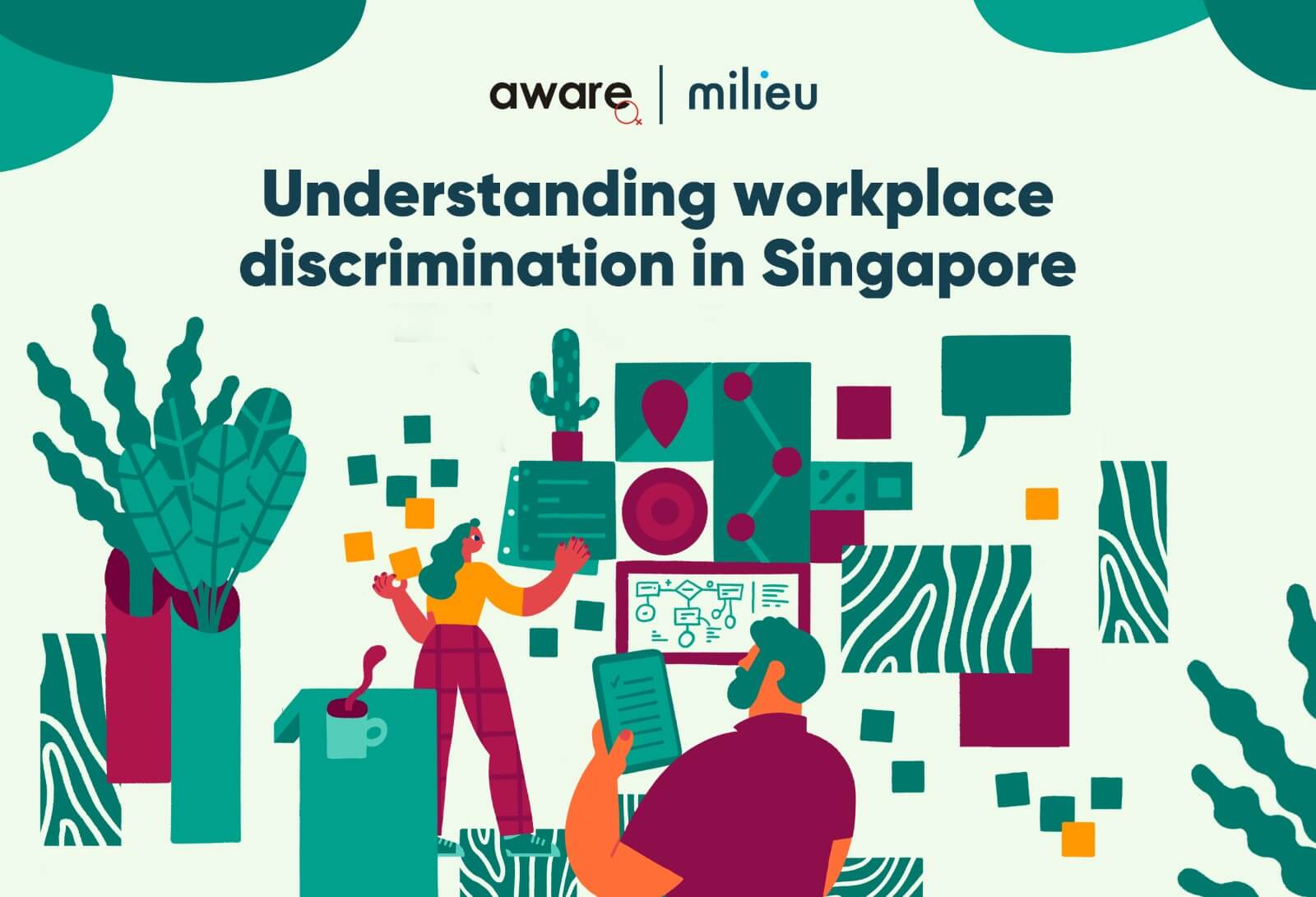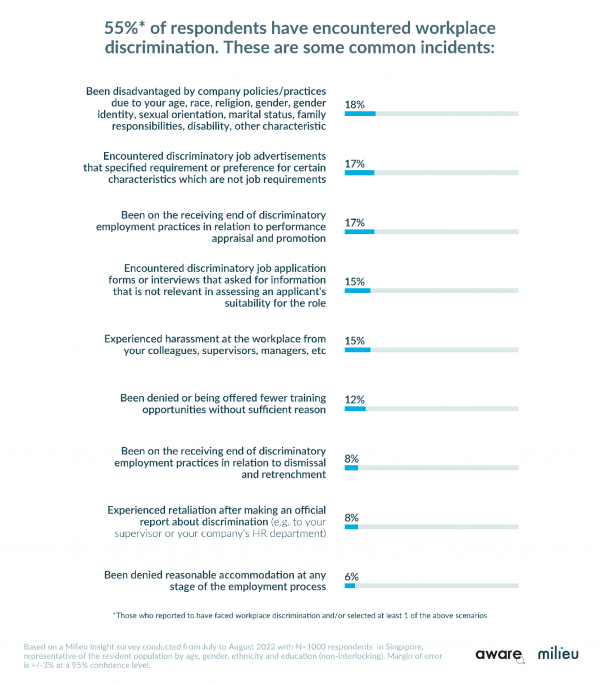-
Advocacy Theme
-
Tags
- Abortion
- Adoption
- Caregiving
- CEDAW
- Disability
- Domestic Violence
- Domestic Workers
- Harassment
- Healthcare
- Housing
- International/Regional Work
- Maintenance
- Media
- Migrant Spouses
- Migrant Workers
- Muslim Law
- National budget
- Parental Leave
- Parenthood
- Polygamy
- Population
- Race and religion
- Sexual Violence
- Sexuality Education
- Single Parents
- Social Support
- Sterilisation
- Women's Charter
1 in 2 experienced workplace discrimination in Singapore over the past five years, with race, age and gender discrimination most common
September 20th, 2022 | Employment and Labour Rights, News, Press Release, Workplace Harassment

This post was originally published as a press release on 20 September 2022.
Around 1 in 2 workers in Singapore experienced workplace discrimination in the past five years, reveals a new survey by gender equality group AWARE in partnership with consumer research company Milieu Insight.
Singapore’s first comprehensive survey on workplace discrimination, it was conducted in August 2022, a year after Prime Minister Lee Hsien Loong announced that the nation would enact anti-discrimination legislation.
The survey polled 1,000 respondents—nationally representative by age, gender and race—on their experiences of (i) direct discrimination, (ii) indirect discrimination and (iii) discrimination-related harassment in the previous five years. To capture the first, respondents were asked if they had ever been treated less favourably than others at work because of their age, race, religion, gender, gender identity, sexual orientation, marital status, family responsibilities, disability or other characteristics. To capture the second, respondents were asked if any company policy or organisational practice had put them and others like them at a particular disadvantage compared with those who did not share the same characteristics. Finally, respondents were asked if they had experienced conduct that made them feel disrespected or that made their work environments intimidating, hostile, degrading, humiliating or offensive, based on aforementioned characteristics.
In total, 55% of respondents had experienced at least one form of discrimination. Certain groups proved more vulnerable to discrimination at work than others: Persons with disabilities experienced discrimination at a significantly higher rate (78%) than persons without disabilities (50%), as did LGBTQ persons (68%) compared to those who did not identify as LGBTQ (56%), and those of minority race (89%) compared to those of majority race (44%). Compared to 53% of men, 58% of women had experienced at least one type of discrimination. Overall, the three most common experiences of discrimination were:
- Unfair company policies or practices, e.g. inaccessible office spaces, or prohibitions against flexible schedules that made it difficult for workers to manage family responsibilities (18% of all respondents experienced this)
- Job advertisements that mandated or specified preference for certain characteristics that were not job requirements (17% of all respondents experienced this)
- Discriminatory employment practices in relation to performance appraisal and promotion, e.g. receiving a poorer performance appraisal after disclosing pregnancy, disability or health conditions (17% of all respondents experienced this)
When asked the grounds upon which they faced discrimination, respondents chose race (41% of those who experienced discrimination), age (35%) and gender (23%) as the top three. Others included: family responsibilities (18%), religion (16%), marital status (11%), medical conditions (7%), sexual orientation (7%), gender identity (6%), pregnancy (6%) and disability (5%). (Respondents could select more than one.)
“Our goal with this survey was for the results to contribute to the drafting of Singapore’s upcoming anti-discrimination legislation—the government’s best opportunity to make far-reaching change in this arena,” said Corinna Lim, executive director of AWARE. “The findings highlight particular ‘pain points’ that deserve attention, such as indirect discrimination, which is frequently left out of conversations and policy decisions. Accordingly, we hope the legislation can employ an expansive definition of discrimination, one that captures the full range of experiences workers face at all points of the employment cycle.”
She noted that AWARE’s Workplace Harassment and Discrimination Advisory (WHDA) has seen a rise in discrimination cases since its inception in 2019. WHDA saw 59 discrimination cases in the first two quarters of 2022, up from 44 in the same period of 2021, and 26 in 2020.
“Furthermore, these results add to the body of evidence that people with marginalised identities are particularly vulnerable,” said Ms Lim, “which is useful, in light of recent national discourse about who requires protection. Anti-discrimination legislation must also include a comprehensive range of protected characteristics, including sexual orientation, gender identity and disability.”
When it came to seeking recourse, 1 in 2 respondents (54%) who had experienced workplace discrimination did not report it to any channels (e.g. Human Resources, a boss or senior, Ministry of Manpower and so on). Those who did not report cited these top reasons: not believing that the discrimination was “severe” enough (36%); not trusting authorities to act on the report (30%) and not having enough evidence of discrimination (29%).
An almost identical proportion of those who reported discrimination (29%) and those who did not report (28%) ended up quitting their jobs. Other actions taken by those who reported included avoiding their perpetrator as much as possible (34%); requesting transfer to another department or location (29%) and refraining from applying for jobs in that industry (13%). Of those who did not report, besides quitting, 23% avoided their perpetrator while 4% requested transfer and another 4% refrained from applying to jobs in that industry.
“The adverse career impacts on even those who did report discrimination are a grim indictment of organisations’ ability to deal with this issue,” said Ms Lim. “It’s clear that companies cannot be relied upon to tackle discrimination on their own without further incentive and guidance. With the government’s leadership, we look forward to a new era of fairer workplaces in Singapore.”
Milieu Insight’s Chief Operating Officer, Stephen Tracy, said, “We conducted this study with AWARE as part of our Milieu for Good program, which seeks to support non-profits through research that helps build greater awareness and understanding of key social issues. The findings of this study highlight just how complex, and sometimes even invisible, issues of discrimination at the workplace can be. I hope managers and senior business leaders will take these results seriously and ensure they’re working to cultivate positive, open and equitable workplace environments.’’
Annex A: Full results for topline findings





Annex B: Case studies from AWARE’s Workplace Harassment and Discrimination Advisory (names have been changed)
Case A
After Elise* had returned from maternity leave, her supervisor yelled at her and disparaged her at a meeting, criticising her “attitude” when she was pregnant and implying that her taking maternity leave showed a lack of concern for her work. Her supervisor subsequently continued to verbally harass her on multiple occasions and explicitly stated that he had no remorse about doing so. Elise found that she was being left out of meetings. Eventually, she felt she had no choice but to resign from the company.
Case B
Maya* was the only employee of her ethnicity at her company. Her supervisor made derogatory comments about her accent, and she found that she was not given any work to do. After just three weeks, Maya’s employment was terminated. No reason was provided to her and there had been no issues with her performance. On her way out, she was told to “not touch any of our things”.
Case C
Pooja* was given a poor performance appraisal just before she reached the eligible age for re-employment. She had displayed stellar performance during her time at the company prior to this. There was no feedback or discussion regarding her performance. Shortly after, she was terminated.



